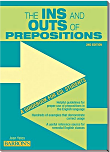

| Book of the Month | ||
 |
The Ins and Outs of Prepositions |  |
Publisher: Barron's
Author: Jean Yates
$12.99
ISBN 978-007461472892
Most languages have prepositions, but English is exceptional in making its preopsitions work harder than most. This is because while many languages have prepositions of movement, for example 'towards' or 'into' or prepositions of place such as 'in', 'on' and 'at', English also uses prepositions as modifiers, especially with phrasal verbs. These can change the meaning of a word completely, so that while 'get' means 'obtain' or 'become', to 'get on' can mean to become old as well as to board something, and 'get over' means to recover from something (for example an illness or a bad boyfriend) as well as to physically lift oneself over an object. Therefore a book on prepositions is a useful and very functional addition to a language student's library.
There are 303 pages in this book, which also has a large format. The weight and size of this chunky volume means that it is not something you'd want to carry around regularly. Most of the book is exactly what it says on the cover - prepositions and how they are used. At the start of the book is an introduction explaining why English prepositions are different from those of other languages and giving details and examples of the different uses. In the main part of the book there are 61 English prepositions from 'about' to 'without' and each is given its own page, or pages if required. The result is that the book is somewhat unbalanced, with lots of empty space on some pages - for example the word 'far' takes up just a few lines of text on an otherwise empty page. Then comes the next entry which is 'for' and the uses of this preposition, with examples, take up several densely printed pages. The design choices are unfortunate, with plenty of bold text which eventually becomes painful on the eye. The examples are useful, and the author also explains whether each word usage is a phrasal verb or indicates tense or word placement. Other sections give uses of prepositions by function. These describe, for example the different meanings of 'on time' as opposed to 'in time'. A glossary of almost 50 pages at the back of the book gives references to each preposition and where and how it is used.
Who is this book for? One of the problems with the use of prepositions, particularly with phrasal verbs is that there is no 'rule' that students can learn. To some extent the allocation of prepositions to actions is almost random. For example there is no logical reason why 'look in' means to make a quick visit whilst 'look into' means to investigate. So the only way to master prepositions is to learn each individually. Therefore it makes sense for a language student to have a book on hand to dip into, browse through and look things up. There are also dictionaries of phrasal verbs available, but prepositions have more uses than just in phrasal verbs, so in many ways this book is the more useful choice.
Verdict: Good book, bad layout.
Assessment 6/10